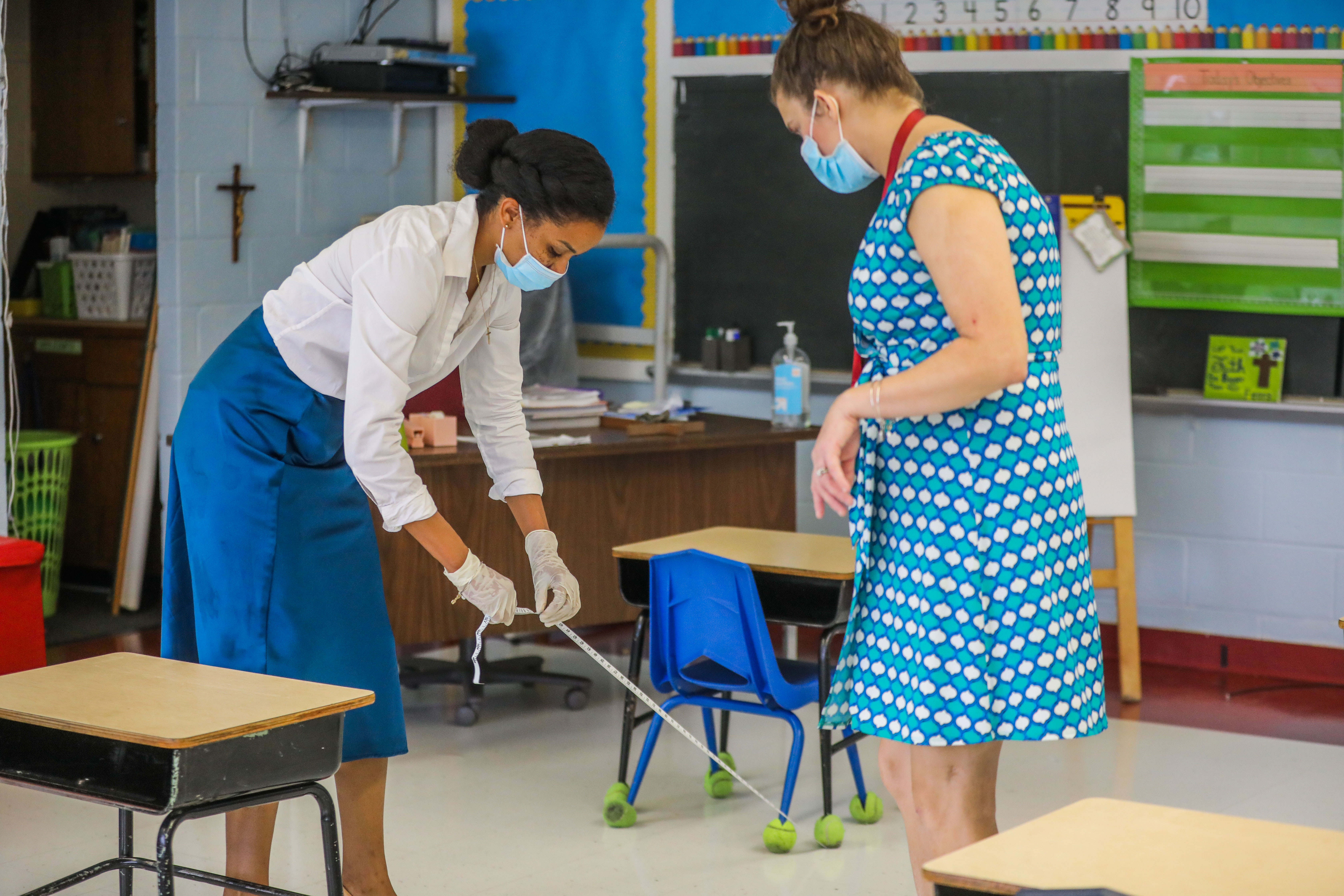In preparation for the new school year during the COVID-19 pandemic, each Catholic school in the Archdiocese of Washington has developed its own reopening plan, had the plan reviewed and approved by the Catholic Schools Office’s reopening task force, and will resume classes this fall in a manner they have determined best for their local school community.
“The reopening task force – composed of school leaders, pastors, nurses, members of the Catholic Schools office, (Archdiocesan) Pastoral Center staff, and community members – developed a framework for safely reopening schools,” said Kelly Branaman, Secretary for Catholic Schools and the Superintendent of Schools for the Archdiocese of Washington. “Using this guidance, each school created a plan for how to reopen safely for the 2020-21 school year.”
She added that “reopening our schools in a manner that is safe for our students and faculty has been our priority,” and each Catholic school was “empowered to devise their own local reopening model and plan for implementation.”
As the archdiocese's reopening plan for Catholic schools was released, Washington Archbishop Wilton Gregory said in a video address to teachers and staff, “Because the pandemic is a health matter, a great deal of consideration was given to thoroughly research safe practices for return. As we move to reopen schools for the new school year in a variety of models, we will take a careful step toward normalcy in our daily lives. This will be a long journey – one that will rely on our perseverance and our commitment to the new health and safety guidelines that will govern how schools operate.”
Following Archbishop Gregory’s directive to shut down as a safety precaution against the spread of the coronavirus, Catholic school campuses in the archdiocese abruptly closed their doors Friday March 13 and implemented distance learning on Monday March 16.
Each school reopening plan, Branaman stressed, adhered to “health and safety protocols (which) were established based on guidance from the Centers for Disease Control, state guidelines, and local jurisdictions,” and “a great deal of consideration was given to thoroughly research safe practices for return.”

In a report released Aug. 18, titled “Onward Together in Faith,” the task force outlined three possible return-to-school models available this fall in Catholic schools throughout the archdiocese:
• Distance learning, where all instruction will be offered virtually with no in-person gatherings for students.
• Blended learning that combines in-person and distance learning where strict health and safety measures are enforced and students and staff will be screened daily before being allowed to enter the building.
• Modified classroom, where schools will be open for in-person instruction, preventative measures will be enforced, face coverings will be required at all times, classroom setups will provide for social distancing, and students and staff will be screened daily before being allowed to enter the building.
“The localized governance structure and autonomy of our Catholic schools makes it possible for each school to meet the needs of their particular community,” Branaman said. “This is indeed a gift of Catholic education.”
Of the Catholic schools in the Archdiocese of Washington, 28 percent are following the distance learning model, 49 percent chose the blended learning model and the remaining 23 percent are following the modified classroom option. The end of the archdiocese’s school reopening document includes links to the websites of the archdiocesan Catholic schools and early learning centers, where individual reopening plans for each campus can be found.
“As an educator, my desire for our students at this time is two-fold: I value the need to bring our students back to campus as soon as reasonably possible, and I recognize the importance of a measured approach to campus reopening that considers all health and safety precautions,” Branaman told parents and guardians of Catholic school students in a letter accompanying the task force report.
She added that she was “particularly moved and impressed by (each school’s) thoroughness and all of the factors considered by our pastor and principals in making their reopening decision.” She said all schools are required to follow strict preventative practices, including social distancing, use of face coverings, frequent hand washing and use of hand sanitizer, daily screenings and increased building cleaning.

The task force, in its opening framework report, noted that each school “utilized information and guidance from the Centers for Disease Control and Prevention, American Academy of Pediatrics, National Association of School Nurses, and state health departments as a part of planning to develop protocols for students and staff to promote good health and safety” and that each school “obtained support from their individual communities by engaging staff, students, families, and community partners in planning for the 2020-21 school year.”
“Partnership with parents and guardians in the education of their children is the purpose of the Catholic education ministry and each of our schools,” the task force report said. “Our schools will depend on parents and guardians to strictly adhere to all health and safety guidelines provided by their school as, together, we continue to navigate the coronavirus pandemic.”
In addition to those three options, the Catholic Schools Office is also offering a “Temporary Transfer Program.” In this program, Branaman explained, “parents who would prefer distance learning for their child are able to work with their current school principal and the Catholic Schools Office to transfer to a school offering virtual instruction full time until such time the parent feels comfortable returning to in-person instruction.”
Because “Catholic identity and the spiritual formation of our students is foundational to the mission of Catholic schools” and prayer and celebration of the Eucharist are “an integral component” to Catholic education, the task force is reassuring parents that “care will be taken to provide access to the celebration (of Mass) whether in person or virtually. Every school will have a call to prayer each day and religion classes will have the opportunity to experience prayer services.”
The task force also reported that each school’s policy handbook has been updated and now includes its approved COVID-19 reopening model and also addresses “operational policies and procedures to consider arrival and dismissal plans, building entry, daily arrival screening for employees and students, (and) parent and essential visitor policies and procedures.”
“Maintaining a safe and healthy environment for students, faculty, and staff is at the forefront of each campus reopening plan,” Branaman said. “We are also mindful of the importance of creating a sense of normalcy for each of our students as we continue to navigate the pandemic crisis.”
Branaman stressed that “each (local school) community must work together to ensure compliance with the guidelines to maintain a safe environment for all.”

In a letter earlier this month to school leaders outlining the reopening procedures, Branaman thanked and praised school staff for their “steadfast and pastoral leadership of Catholic schools during this time of uncertainty... We have endured keeping the safety of our staff, students and their families as our highest priority while also delivering high quality academic instruction and faith formation.”
Branaman said that since every school in the Archdiocese of Washington has an approved reopening plan, individual schools “are currently in the process of communicating them to their communities.”
About 26,000 students attend classes at 91 archdiocesan and independent Catholic pre-kindergarten through high schools located in the Archdiocese of Washington. The archdiocese’s Catholic schools are located in Washington, D.C., and five Maryland counties: Calvert, Charles, Montgomery, Prince George’s and St. Mary’s. The beginning of the school year varies by region, with the earliest start date Aug. 25, and the latest Sept. 8.












